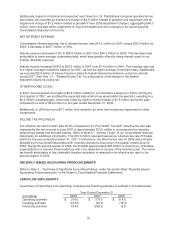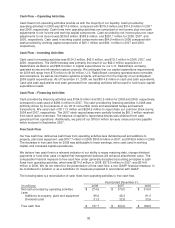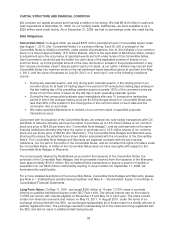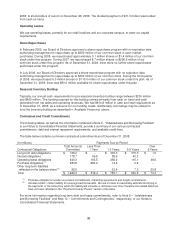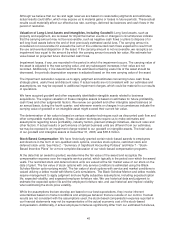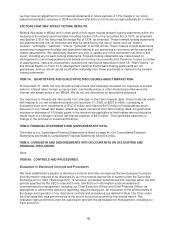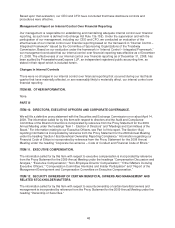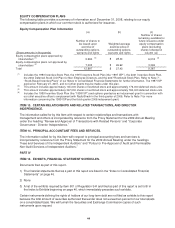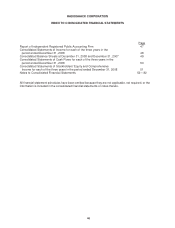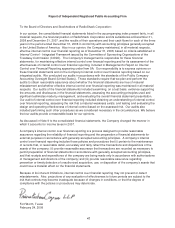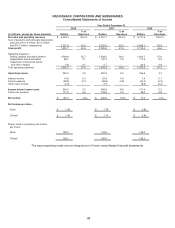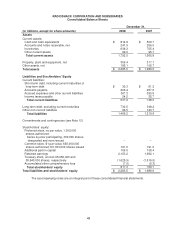Radio Shack 2008 Annual Report Download - page 47
Download and view the complete annual report
Please find page 47 of the 2008 Radio Shack annual report below. You can navigate through the pages in the report by either clicking on the pages listed below, or by using the keyword search tool below to find specific information within the annual report.approximates FIFO) or market. The cost components recorded within inventory are the vendor invoice
cost and certain allocated external and internal freight, distribution, warehousing and other costs relating
to merchandise acquisition required to bring the merchandise from the vendor to the point-of-sale.
Typically, the market value of our inventory is higher than its aggregate cost. Determination of the market
value may be very complex and, therefore, requires a high degree of judgment. In order for management
to make the appropriate determination of market value, the following items are commonly considered:
inventory turnover statistics, current selling prices, seasonality factors, consumer trends, competitive
pricing, performance of similar products or accessories, planned promotional incentives, technological
obsolescence, and estimated costs to sell or dispose of merchandise such as sales commissions.
If the estimated market value, calculated as the amount we expect to realize, net of estimated selling
costs, from the ultimate sale or disposal of the inventory, is determined to be less than the recorded cost,
we record a provision to reduce the carrying amount of the inventory item to its net realizable value.
Differences between management estimates and actual performance and pricing of our merchandise
could result in inventory valuations that differ from the amount recorded at the financial statement date
and could also cause fluctuations in the amount of recorded cost of products sold.
If our estimates regarding market value are inaccurate or changes in consumer demand affect certain
products in an unforeseen manner, we may be exposed to material losses or gains in excess of our
established valuation reserve.
Estimation of Reserves and Valuation Allowances: The amount of liability we record for claims related
to insurance, tax and legal contingencies requires us to make judgments about the amount of expenses
that will ultimately be incurred. We use our history and experience, as well as other specific circumstances
surrounding these claims, in evaluating the amount of liability we should record. As additional information
becomes available, we assess the potential liability related to our various claims and revise our estimates
as appropriate. These revisions could materially impact our results of operations and financial position or
liquidity.
We are insured for certain losses related to workers' compensation, property and other liability claims, with
deductibles up to $1.0 million per occurrence. This insurance coverage limits our exposure for any
catastrophic claims that may arise above the deductible. We also have a self-insured health program
administered by a third-party covering the majority of our employees that participate in our health
insurance programs. We estimate the amount of our reserves for all insurance programs discussed above
at the end of each reporting period. This estimate is based on historical claims experience, demographic
factors, severity factors, and other factors we deem relevant. A 10% change in our insurance reserves at
December 31, 2008, would have affected net income by approximately $5.7 million. As of December 31,
2008, actual losses had not exceeded our expectations. Additionally, for claims that exceed our deductible
amount, we record a gross liability and corresponding receivable representing expected recoveries, since
we are not legally relieved of our obligation to the claimant.
We are subject to periodic audits from multiple domestic and foreign tax authorities related to income tax,
sales and use tax, personal property tax, and other forms of taxation. These audits examine our tax
positions, timing of income and deductions, and allocation procedures across multiple jurisdictions. As
part of our evaluation of these tax issues, we establish reserves in our consolidated financial statements
based on our estimate of current probable tax exposures. Effective January 1, 2007, we began
recognizing uncertain income tax positions based on our assessment of whether the tax position was
more likely than not to be sustained on audit, as set forth within FASB Interpretation No. 48, “Accounting
for Uncertainty in Income Taxes, an Interpretation of FASB Statement No. 109.” Depending on the nature
of the tax issue, we could be subject to audit over several years; therefore, our estimated reserve
balances might exist for multiple years before an issue is resolved by the taxing authority.
Additionally, we are involved in legal proceedings and governmental inquiries associated with employment
and other matters. A reserve has been established based on our best estimate of the probable losses in
these matters. This estimate has been developed in consultation with in-house and outside legal counsel
and is based upon a combination of litigation and settlement strategies.
40



